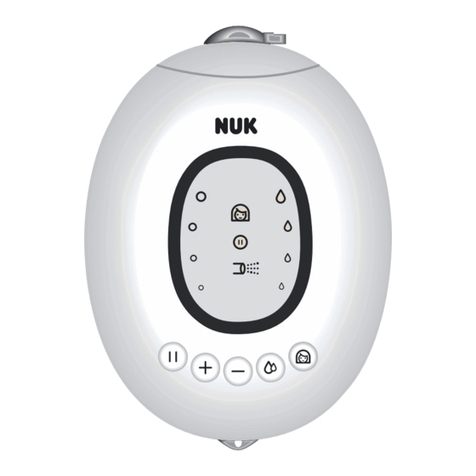7
5. Disassembly of the Pump
For the following please refer to “Overview
of Parts”.
CAUTION: Always hold the breast milk
container (8) upright when it contains milk
or the milk may spill out.
1. Unplug the voltage adapter (14) from
the pump unit (13).
2.Unscrew the shield connector (4) and
tubing (9) from the back of the breast
shield (2).
3.Unscrew the breast milk container (8)
from the connection ring (5).
4.Unscrew the connection ring (5) from
the breast shield (2).
5.Remove the backow valve (6) from the
breast shield (2).
6. Carefully remove the membrane (7) from
the backow valve (6) by pulling outwards.
7. Remove the tubing (9) from the shield
connector (4) and tubing connector
(10). Inspect tubing for condensation
or breast milk. If either appears, refer
to “Section 6.1 Cleaning the Tubing” to
immediately clean the tubing.
6. Cleaning
Hygiene is of priority when handling
breast milk and all parts that come
into contact with it. The pump should
therefore only be used in a clean and
sanitized condition. All accessories and
parts that come into contact with breast
milk – silicone breast cushion (1), breast
shield (2), connection ring (5), backow
valve (6), membrane (7), and breast
milk container (8) – must be thoroughly
cleaned prior to use. Insufcient cleaning
of the pump and/or components can lead
to contamination. Follow the instructions
to ensure proper cleaning.
NOTE: Prior to rst use, sanitize the breast
milk container (8) and nipple (15) by boiling
in water for 5 minutes. Use caution when
removing components from hot water.
CAUTION: Unplug the voltage adapter (14)
from the power outlet before cleaning.
1. Disassemble the pump according to
Section 5.
2. After each use, wash the following parts
by hand: silicone cushion (1), breast shield
(2), connection ring (5), backow valve (6),
membrane (7), and breast milk container
(8). Wash parts using plenty of warm
water and liquid dishwashing soap, then
rinse with hot water for 10 to 15 seconds.
Clean the membrane (7) carefully to avoid
damaging the material. Allow all parts
to dry completely before next use. The
breast milk container (8), collar (16), nipple
(15) and seal disk (17) can also be cleaned
by boiling or in the dishwasher (top-rack).
NOTE: The following parts should be
cleaned as needed: pump unit (13), silicone
gasket (3), shield connector (4), silicone
tubing (9), tubing connector (10), connector
(12), and connector cap (11). If the silicone
gasket (3), shield connector (4), tubing
connector (10), connector (12) or connector
cap (11) come into contact with breast milk
or need cleaning, carefully wash these
03_62772_5112_A_DEBP_Booklet_REL_2-19-13_Added pages divisible by 4.indd 7 3/18/2013 2:26:55 PM




























